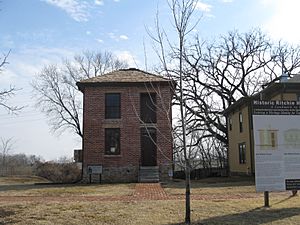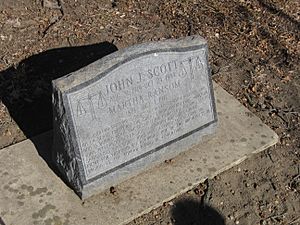John Ritchie (abolitionist) facts for kids
John Ritchie (born July 17, 1817, died August 31, 1887) was an American who fought against slavery. He lived in Kansas and served in the Union Army during the American Civil War.
Contents
Early Life in Kansas
John Ritchie moved from Franklin, Indiana to Topeka, Kansas, in 1855. He wanted to find affordable land. He also wanted to help Kansas join the United States as a "free" state. This meant Kansas would not allow slavery.
His wife, Mary Jane Shelledy Ritchie, was one of the first women to settle in Topeka. Their young son, Hale, was one of the first children there. When they first arrived, they lived in a simple dugout home. Around 1856, they built a stone house. This house still stands in Topeka today.
Ritchie helped shape Kansas's future. He was chosen to be a delegate at two important meetings. These meetings were held to write the state's constitution. They were the Leavenworth (1858) and Wyandotte (1859) conventions.
Fighting Against Slavery
Ritchie was part of a difficult time in Kansas history called Bleeding Kansas. During this time, people fought over whether Kansas would allow slavery. Ritchie was very active in stopping slavery from spreading.
He worked closely with a well-known leader named James H. Lane. Ritchie was also part of a group called the "Topeka Boys." He ran a secret "station" on the Underground Railroad. This was a network of safe houses and routes. It helped enslaved people escape to freedom. In January 1859, Ritchie helped John Brown and eleven enslaved people escape. They avoided federal troops and reached safety in Nebraska.
Service in the Civil War
When the American Civil War began, John Ritchie joined the Union Army. With support from James H. Lane, he became a lieutenant colonel. He served in the 5th Regiment Kansas Volunteer Cavalry. Later, he became a colonel. He led the 2nd Regiment, Indian Home Guard. This unit included Native American soldiers. On February 21, 1865, he was given a special honor. He received a brevet promotion to brigadier general. This was a higher rank given for good service.
Helping the Community
After the Civil War, many newly freed African Americans moved to Topeka. This happened before and during the Exodus movement. John Ritchie sold or gave them land to build homes. Because many African Americans lived there, the Topeka School District built a school for Black children. This school was called Monroe School. It was built in the area Ritchie helped settle, known as "Ritchie's Addition."
Monroe School later became very important. It was at the center of the famous Brown v. Board of Education court case. This case fought against segregated public schools.
Ritchie Cemetery
Ritchie also gave land for a free cemetery. This was a place where people who could not afford burial plots could bury their loved ones. It is thought that about 100 people are buried there. Most of the graves do not have markers. The cemetery is located at 27th and Boswell Avenue in Topeka.
His wife, Mary Jane, and their young daughter were first buried there. However, after John Ritchie died at age 70, his son Hale moved their remains. They were reburied with John Ritchie in the Topeka Cemetery.
Supporting Education and Women's Rights
John Ritchie bought 160 acres (0.65 square kilometers) of land in Topeka. He then donated this land to a school called Lincoln College. This college later became Washburn College and is now known as Washburn University. His donation helped the college grow and have a larger campus.
Ritchie was also a strong supporter of women's rights. At the Wyandotte Constitutional Convention, he tried to include women's rights in the state's constitution. Famous women's rights leaders Susan B. Anthony and Elizabeth Cady Stanton stayed with the Ritchie family. They were in Topeka to speak at the state capitol.




